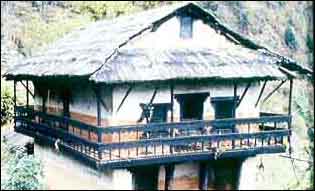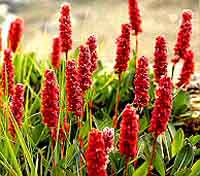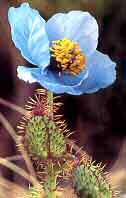| Mountaineering
Across the Himalayas - Part 3
|
|||||
The beginning of a New Odyssey
Dharchula marked another significant milestone. Three of us, - Malika Virdi, Sumita Roy and I - decided to break away from the group and form an independent team to complete the venture since we had several points of dissent with the leader.
On June 8 we submitted our resignations and after some official paperwork set off again. We worked hard. Divyesh Muni, helped us in arranging for finances. E. Theo helped in arranging for permits for the border areas.
In Munsiari we re-organised ourselves and after hectic preparation set off on June 16 with a new name: "To Walk Across the High Himalaya : A Journey by Indian Women '97." Our onward journey was sponsored by The Himalayan Club.
In Eastern Garhwal, from Munsiari we trekked to Martoli along the Gori Ganga. From Milam we entered the Goenka gad. With a support team and porters, we crossed over the Unta Dhura (5,360 m), climbing the Khingurla (5,244 m) and descending at Lapthal. Once the bed of the Tethys sea, long before the Himalayas had been formed, Lapthal became a happy treasure hunting ground.
|
More on Ladakh • An Overview
Mountaineering
Adventure
Travelogues | ||||
 I shrieked with joy when I found my first ammonite fossil-remnants of marine life going back nearly six million years. I clutched this precious, ancient gift from the mountains. We also visited the Matoli Pass (5,350 m) which provides an alternative route to Khingurla from Topidunga. It provided a magnificent view of the valleys all around us.
I shrieked with joy when I found my first ammonite fossil-remnants of marine life going back nearly six million years. I clutched this precious, ancient gift from the mountains. We also visited the Matoli Pass (5,350 m) which provides an alternative route to Khingurla from Topidunga. It provided a magnificent view of the valleys all around us.
History was visible in other forms too. Our trail throughout the Milam glacier up to Malari is part of an old trade route to Tibet and China and is well maintained even today by PWD workers. Now that we were a small group we had to travel as light as possible, eating basic foods like dal, rice, sattu, cheese and dry fruits. For this stretch we had a cook by the name of Duryodhan Singh. His unusual name provided an interesting glimpse into the customs of the region. Duryodhan, head of the Kauravas, is not regarded as a villain in these parts. Instead, he is venerated as a god and there are even temples dedicated to him. We exited at Malari from where we proceeded along the Amrit Ganga river that rises from the snout of Bank Kund glacier. From Malari we trekked on a well trodden path to Gamshali. A road is under construction. From here we reached the base of the Bhuyendar Khal (5,057 m) in 2 days. As the track climbs, the terrain changes from green pastures to the debris of the morain. We carefully chose our route through the glacier, fully aware that the Khal is not technically very difficult but has proved dangerous due to two major crevasses just below the pass. Our experience over the Bhuyendar Khal brought home the fact that any excursion in the Himalayas is a serious affair that must be approached accordingly. The weather packed up as we began our steep ascent over loose scree on the true right of the ice fall. Visibility dropped to 10 ft. The wind chill factor increased every minute. Our 73-year-old guide Madhoda kept issuing directions all the time. Carefully we made our way up the crevassed slopes and then down the long steep slopes to Dhada Kharak at the beginning of The Valley of Flowers. The next day was in marked contrast. We walked down to Bhamanidhowd-into my dream valley, The Valley of Flowers, and was greeted with slope after slope of flowers - in different shapes and colours. This was the valley that Frank Smythe had discovered and named in 1931. Now sixty odd years later, despite the depredations by trekkers and climbers, it was still a most enchanting spot particularly as the flowering season was beginning.
It was good we had no inkling of what the next day would bring us. Our guide, who was once a sheepherd, suggested we go through the Khunt Khal (4,365 m) instead of the Govind Ghat route. This, he said, would bring us out at Hanuman Chatti on a motorable road, 11 kms before Badrinath. The thrill of the unknown was exciting. "The Mystery and thrill of travel is always upon one in the Himalayas, but the mystery is awful and the thrill is sometimes a shudder" - C. F. Meade.
These steep, loose, rocky slopes passed through thick jungle. So sheer was the descent, that we were forced to spend a night in the open wedged between bamboo trees for safety There was, of course, no question of pitching a tent. The Water source was a trickle on the mountainside two kilometres away. As it so often happens in the mountains there was one bright dazzling moment during that unforgettable day-our first and only sighting of the rare Himalayan Blue Poppy.
|
|||||
Editor: Romola Butalia (c) India Travelogue. All rights reserved. |
|||||

 The flowers I saw included Anemone Tetrasepala, Anemone Obtusiloba, Lilium Oxypetalum, Alliumhumile, among a multitude of others. I saw more than fifty varieties of flowers on the whole trail. Since I am not a botanist, many may still have missed my attention as botanical specimens but their vivid colours, delicate shapes and sweet fragrances still linger in my memory. We picked up some raw wild onion leaves and ganjari (a mini carrot) to garnish our khichdi for the night. The lingering fragrance of this magic carpet of flowers kept us company all through the changing landscape.
The flowers I saw included Anemone Tetrasepala, Anemone Obtusiloba, Lilium Oxypetalum, Alliumhumile, among a multitude of others. I saw more than fifty varieties of flowers on the whole trail. Since I am not a botanist, many may still have missed my attention as botanical specimens but their vivid colours, delicate shapes and sweet fragrances still linger in my memory. We picked up some raw wild onion leaves and ganjari (a mini carrot) to garnish our khichdi for the night. The lingering fragrance of this magic carpet of flowers kept us company all through the changing landscape.
 The initial climb with the views of Hathi Parbat and Ghori Parbat shining in the morning light seemed like a good omen. However, we soon realised that we were in wild country. Since the shepherds had been forbidden to enter the Valley of the Flowers the trail had become completely overgrown with trees and shrubs. This was one of the most difficult descents of our venture.
The initial climb with the views of Hathi Parbat and Ghori Parbat shining in the morning light seemed like a good omen. However, we soon realised that we were in wild country. Since the shepherds had been forbidden to enter the Valley of the Flowers the trail had become completely overgrown with trees and shrubs. This was one of the most difficult descents of our venture.